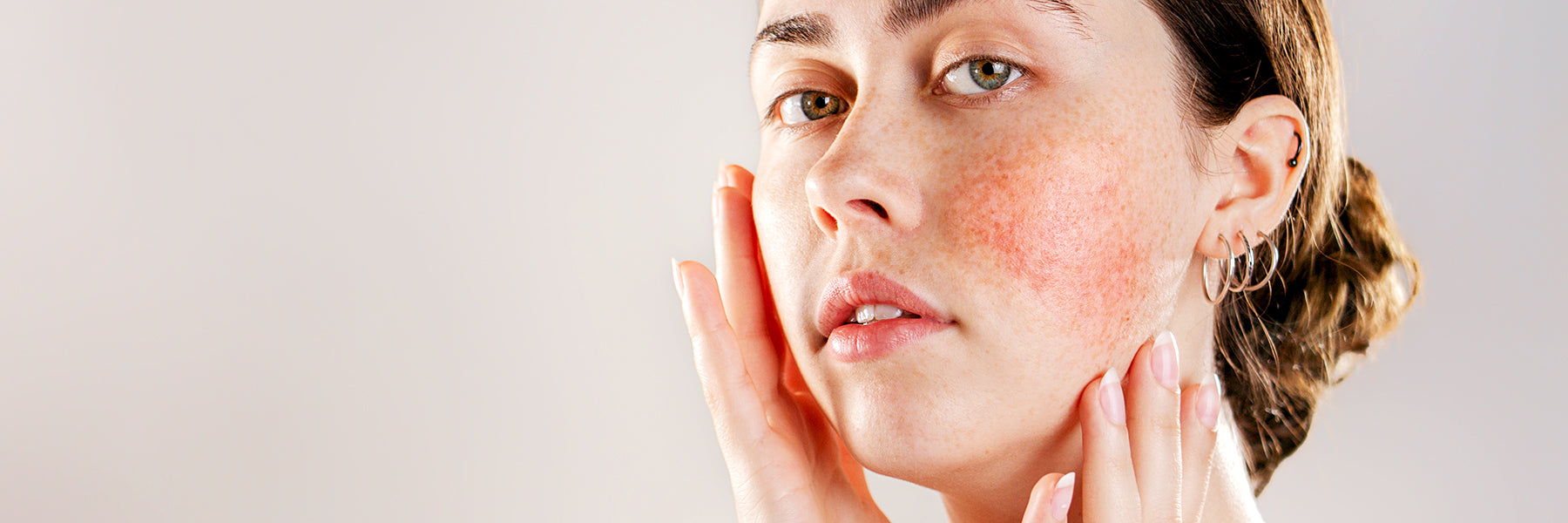
How To Keep Redness Under Control
While many of us have suffered an occasional blush or red face from anxiety, stress or anger, many others endure the condition on a more permanent basis.
If it goes untreated this redness can cause our skin to age faster than normal.
How is that?
When redness or irritation occurs our body detects an aggressor i.e. irritating ingredient, even pollen and revs up our immune system. Skin cells release interleukin-1, a protein that fights foreign substances -- but it's accompanied by an enzyme that also destroys collagen.
That’s why it’s important to target the root of the redness both internally and externally.
No matter the symptom, most skin problems reflect internal issues and rosacea sufferers, in particular, have chronic inflammation in the digestive tract that mirrors what is seen on the face.
Redness can be deceiving. Sometimes we are not quite sure what it is or what is causing it. It could be reactive redness, rosacea or dermatitis.
First determine what type of redness you’re experiencing.
Reactive Redness:
A condition that happens for one of two reasons:
1 - you've used an ingredient your skin doesn't agree with, or
2 - you've overdosed on aggressive ingredients (such as acids or retinol), stripping away the protective dead skin layer aka the skin's acid mantle and leaving fresh skin cells more sensitive.
Solution:
Cleanse skin with Amaranth Gentle Cleanse to remove offending product residue by massaging tepid, not cold, water into skin. Wait for the skin to be completely dry.
Apply High Potency Recovery Gel -- made with glycerin which locks in moisture, alleviating a tight feeling. Take a 2-week vacay from aggressive serums and exfoliants so your skin can rebuild its barrier.
Side note: Synthetic fragrance is one of the most common offenders to causing reactive redness.
If your skin is feeling dry apply a little cherry blossom healing soothe at night.

Rosacea:
The cause is still a mystery. What the pros do know: you can control, not cure, it; It occurs mostly in women with fair skin; and extreme temps, spicy foods and alcohol -- all of which dilate blood vessels -- exacerbate it. If left untreated pimple-like bumps can accompany the rosy tone.
It is a chronic skin disorder in which the face -- most notably the cheeks and nose -- are unusually red. To be truly effective, treatment for rosacea must also focus on the causal level, which is almost always in the digestive system.
First, food triggers must be identified and eliminated. Typical culprits are dairy, grains including corn, peanuts, soy and eggs, nightshade vegetables and citrus fruits.
Solution:
During a flare up, head straight to the freezer, grab an ice cube and start sucking on it. The roof of our mouth houses a receptor site that, when cooled, restricts the blood vessels that lead to the face.
While you're doing that apply a cream with anti-inflammatory ingredients to shrink engorged vessels -- such as sulphur clarifying moisturizer.
If your rosacea is mild, wash with amaranth gentle cleanse ideal for red or sensitive skin. Also avoid skin-stripping retinols and hydroxy acids – opt for products made with gentler peptides, Such as skin boost peptide elixir.
Peptides send a signal to the nerves to slow down muscle movement, softening wrinkles.
One of the simplest solutions to minimizing flare-ups is to cut out what's triggering your symptoms. Perhaps keep a skin diary to identify triggers.
Although the redness may come and go, eventually it may become permanent. While the causes of this condition aren't yet known, several factors are believed to contribute to it.
- The expansion of the small blood vessels in the face, often caused by extreme temperature changes, can lead to reddening of the skin and rosacea.
- Alcohol, infection, stress, B vitamin deficiencies and gastrointestinal disorders are known to dilate the small facial veins, causing rosacea.
What makes one person's condition worse, however, might not effect another person's. Natural steps to treat the problem include dietary changes, stress reduction and nutritional supplements such as probiotics, omega 3 fatty acids (salmon, flaxseed oil).
Dermatitis:
Two issues fall under this umbrella.
- Itchy, dry patches (known as atopic dermatitis, or eczema) occur if you're overly sensitive to allergens or have a weak skin barrier.
- Flakiness, which points to seborrheic dermatitis, caused by an excessive amount of your body's naturally existing yeast.
Solution:
Cleanse with Amaranth Gentle Cleanse and use the silicone facial scrubber to gently dislodge dry skin flakes.
Twice per day apply Willowherb Serum followed by Avocado + Apricot (day) and Cherry Blossom Soothe (night). This will help to reduce inflammation and calm the skin.
It can take two to four weeks to relieve redness with the above skin care solutions period until they start to work their magic, try this duo of concealing tips makeup concealing tips:
1) Even out skin tone with a stick foundation. The tone should match the natural shade of your skin when it's not red; Use your neck as a guide.
As makeup dries, it can get stuck on flaky skin. To keep skin moist, top makeup with a thin layer of cherry blossom healing soothe.
2) Glow, don't blush. The rosy hue of blush can make already red skin look redder. For a fresh face finish, tap a peach toned blush such as Say Her Name or Georgia Peach by Plain Jane Beauty.
The more you understand the triggers for skin redness, the more you'll be able to help avoid flare-ups and enjoy calmer skin.
Leave any question below or book a 15-minute skincare consult.


Leave a comment